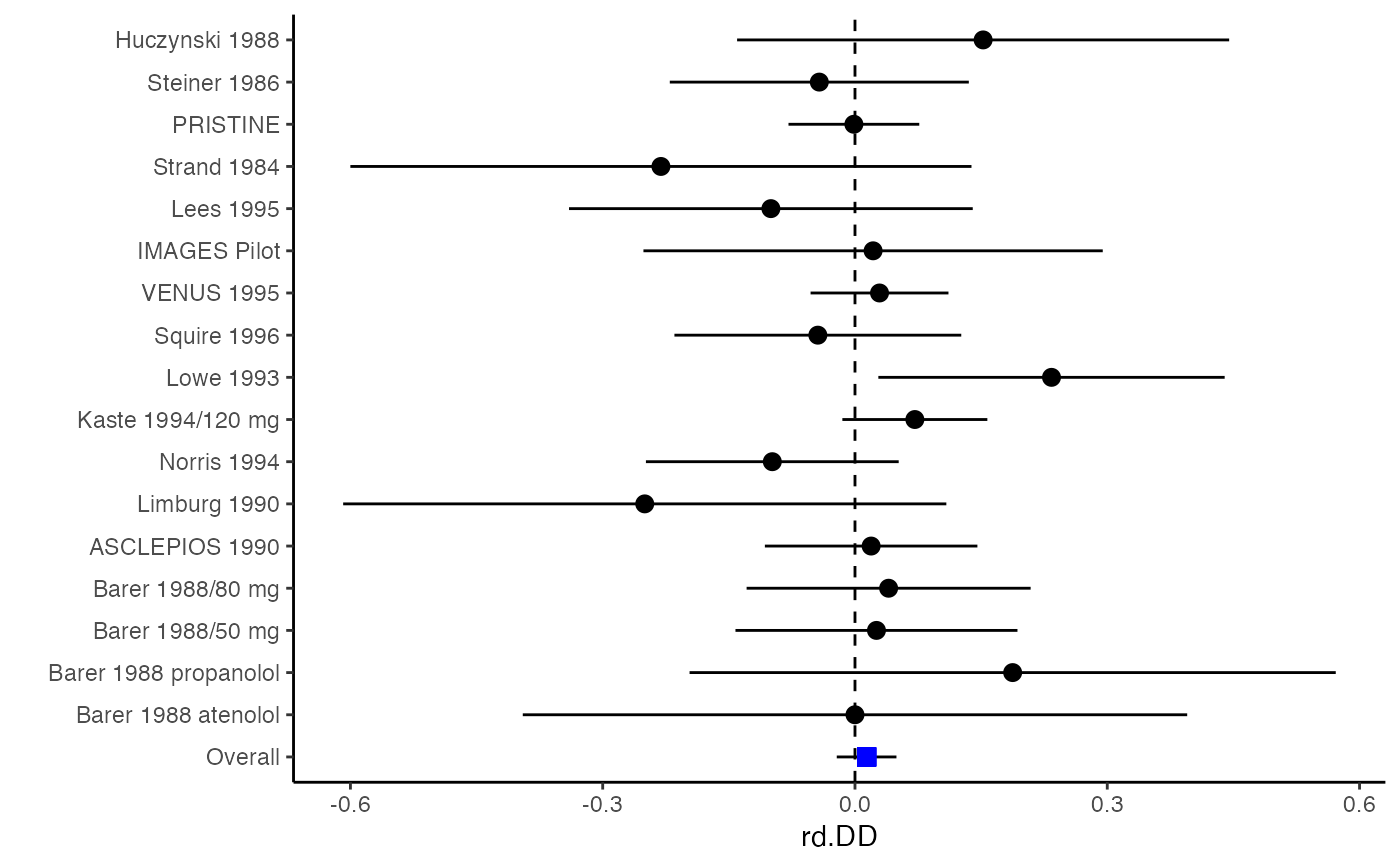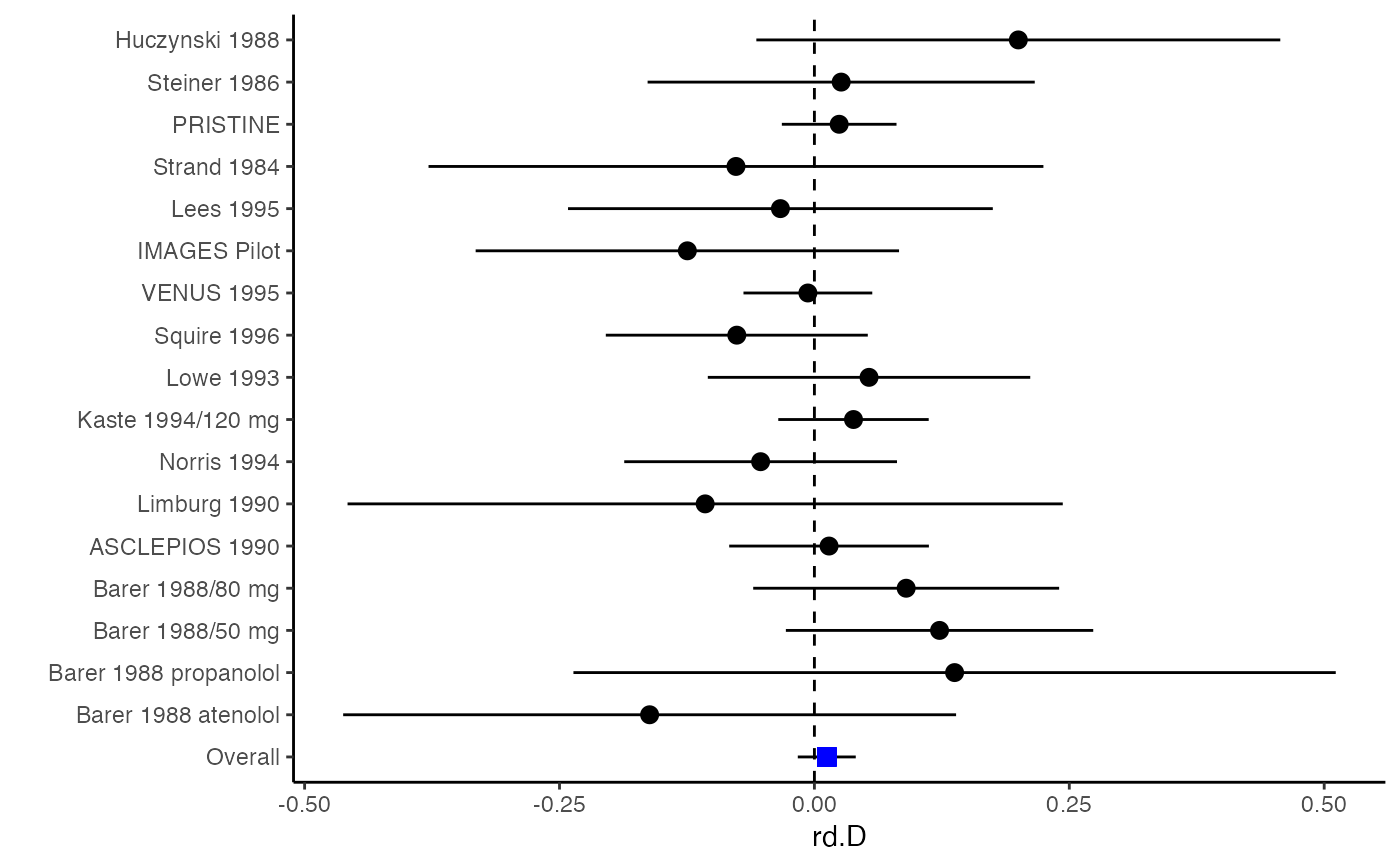Computing Variance-Covariance Matrices for Risk Differences
rd.vcov.RdThe function lgOR.vcov computes effect sizes and variance-covariance matrix for multivariate meta-analysis when the effect sizes of interest are all measured by risk difference. See mix.vcov for effect sizes of the same or different types.
rd.vcov(r, nt, nc, st, sc, n_rt = NA, n_rc = NA)
Arguments
| r | A \(N\)-dimensional list of \(p \times p\) correlation matrices for the \(p\) outcomes from the \(N\) studies. |
|---|---|
| nt | A \(N \times p\) matrix storing sample sizes in the treatment group reporting the \(p\) outcomes. |
| nc | A matrix defined in a similar way as |
| st | A \(N \times p\) matrix recording number of participants with event for all outcomes (dichotomous) in treatment group. |
| sc | Defined in a similar way as |
| n_rt | A \(N\)-dimensional list of \(p \times p\) matrices storing sample sizes in the treatment group reporting pairwise outcomes in the off-diagonal elements. |
| n_rc | A list defined in a similar way as |
Author
Min Lu
Value
A \(N \times p\) data frame whose columns are computed risk differences.
A \(N\)-dimensional list of \(p(p+1)/2 \times p(p+1)/2\) matrices of computed variance-covariance matrices.
A \(N \times p(p+1)/2\) matrix whose rows are computed variance-covariance vectors.
References
Ahn, S., Lu, M., Lefevor, G.T., Fedewa, A. & Celimli, S. (2016). Application of meta-analysis in sport and exercise science. In N. Ntoumanis, & N. Myers (Eds.), An Introduction to Intermediate and Advanced Statistical Analyses for Sport and Exercise Scientists (pp.233-253). Hoboken, NJ: John Wiley and Sons, Ltd.
Wei, Y., & Higgins, J. (2013). Estimating within study covariances in multivariate meta-analysis with multiple outcomes. Statistics in Medicine, 32(7), 119-1205.
Examples
########################################################################### # Example: Geeganage2010 data # Preparing risk differences and covariances for multivariate meta-analysis ########################################################################### data(Geeganage2010) ## set the correlation coefficients list r r12 <- 0.71 r.Gee <- lapply(1:nrow(Geeganage2010), function(i){matrix(c(1, r12, r12, 1), 2, 2)}) computvcov <- rd.vcov(nt = subset(Geeganage2010, select = c(nt_DD, nt_D)), nc = subset(Geeganage2010, select = c(nc_DD, nc_D)), st = subset(Geeganage2010, select = c(st_DD, st_D)), sc = subset(Geeganage2010, select = c(sc_DD, sc_D)), r = r.Gee) # name computed relative risk as y y <- computvcov$ef colnames(y) <- c("rd.DD", "rd.D") # name variance-covariance matrix of trnasformed z scores as covars S <- computvcov$matrix.vcov ## fixed-effect model MMA_FE <- summary(metafixed(y = y, Slist = computvcov$list.vcov)) ####################################################################### # Running random-effects model using package "mvmeta" or "metaSEM" ####################################################################### #library(mvmeta) #mvmeta_RE <- summary(mvmeta(cbind(rd.DD, rd.D), # S = S, data = as.data.frame(y), # method = "reml")) #mvmeta_RE # maximum likelihood estimators from the metaSEM package # library(metaSEM) # metaSEM_RE <- summary(meta(y = y, v = S)) # metaSEM_RE ############################################################## # Plotting the result: ############################################################## obj <- MMA_FE # obj <- mvmeta_RE # obj <- metaSEM_RE # pdf("CI.pdf", width = 4, height = 7) plotCI(y = computvcov$ef, v = computvcov$list.vcov, name.y = c("rd.DD", "rd.D"), name.study = Geeganage2010$studyID, y.all = obj$coefficients[,1], y.all.se = obj$coefficients[,2])#> $`Plotting rd.DD`#> #> $`Plotting rd.D`#># dev.off()

